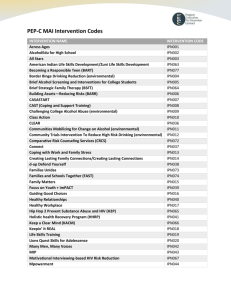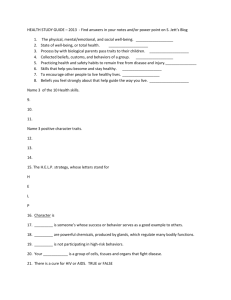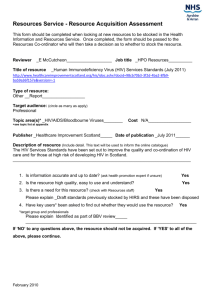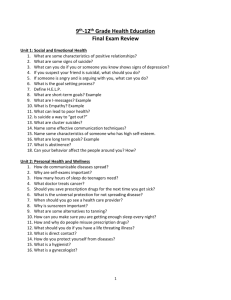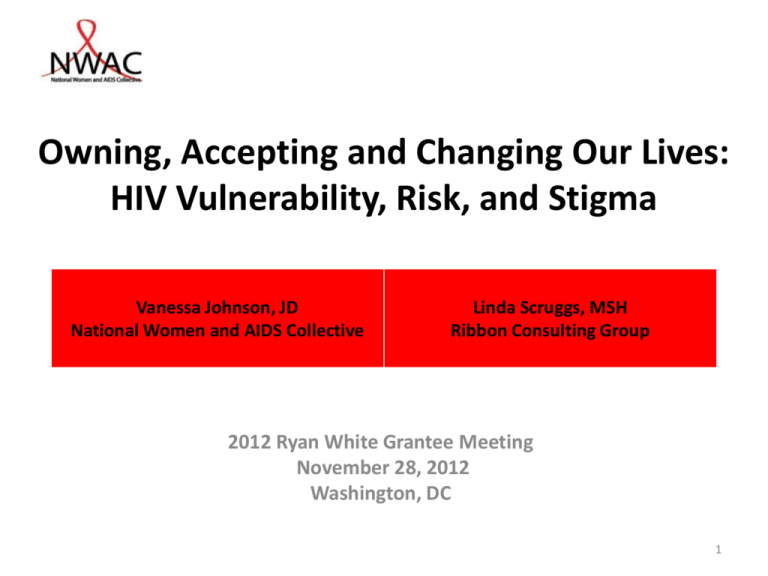
Owning, Accepting and Changing Our Lives:
HIV Vulnerability, Risk, and Stigma
Vanessa Johnson, JD
National Women and AIDS Collective
Linda Scruggs, MSH
Ribbon Consulting Group
2012 Ryan White Grantee Meeting
November 28, 2012
Washington, DC
1
Building Storytellers
• Common Threads is a small group HIV prevention
training organized around intense, interactive, skillbuilding sessions. This training is designed to
enhance the ability of women living with HIV/AIDS to
share their life experiences (including their
experiences with HIV/AIDS and other health
disparities) with family members, partners, friends,
and community members.
Building Storytellers
• WHY
1. Decrease HIV/AIDS related stigma.
2. Increase HIV testing and/or linkage to health
care by improving the delivery of HIV and other
health prevention messages.
3. Decrease HIV transmission and other poor
health outcomes.
4. Build a partnership between HHS/OWH
personnel and WLHIV in order to support the
implementation of the National HIV/AIDS
Strategy.
Building Storytellers
• WHAT
1. To teach participants how to make and/or use
storytelling tools: storytelling template, HIV
testing & diagnosis experience, family history
(tree), and personal timeline
2. To provide participants the opportunity to
practice and build their confidence and comfort
via participant exchange sessions and practice
demonstrations
3. To provide practice feedback to improve future
presentations
4
Building Storytellers
• HOW!
– Through mini-lectures, demonstration, discussion,
examples, crafting, and practice participants will
become acquainted with simple but effective
storytelling tools:
•
•
•
•
Storytelling Templates
Family Tree
Personal Timeline
Narrative (HIV Testing & Diagnosis Experience)
5
Building Storytellers
• Key Training Elements
1. Provide an overview of the AIDS Epidemic and how it
impacts women, especially women of African descent.
2. Provide an overview of NHAS goals
3. To provide an overview of Common Threads goals
4. To introduce the concept of HIV vulnerability and how
HIV vulnerability may arise from the interconnectedness
of the participants’ life experiences.
5. To role model four (4) storytelling techniques
6. To provide participants with an opportunity to develop
and practice presentations.
Women and HIV Vulnerability
IMPACT ON
Prevention, Testing, Linkage to Care and Retention in Care
SOCIAL DETERMINANTS
(c) 2012 Just Cause Consulting
STRUCTURAL FACTORS
BEHAVIORAL HEALTH
7
Presentation Outline
Women and HIV Vulnerability
• Learning Objectives
• Identify & Explore
Vulnerability Factors
• Exercises
(c) 2012 Just Cause Consulting
8
Women and HIV Vulnerability
Learning Objectives
• To learn the definitions for HIV risk and HIV
vulnerability
• To become acquainted with factors (or
conditions) which can increase one’s
vulnerability to HIV
• To explore the correlation between life
experiences and circumstances and HIV
vulnerability.
9
Defining HIV Risk and Vulnerability
UNAIDS (2007)
• Risk is defined as the probability or likelihood that a
person may through their own actions become infected
with HIV. Certain behaviors create, increase, and
perpetuate risk. Examples include:
– unprotected sex with a partner whose HIV status is unknown,
– multiple sexual partnerships involving unprotected sex,
– and injecting drug use with contaminated needles and
syringes.
(c) 2012 Just Cause Consulting
10
Defining HIV Risk and Vulnerability
UNAIDS (2007)
• Vulnerability results from a range of factors
outside the control of the individual that
reduce the ability of individuals and
communities to avoid HIV risk.
– These factors may include:
• lack of knowledge and skills required to protect oneself
and others;
• factors pertaining to the quality and coverage of
services (e.g. inaccessibility of service due to distance,
cost or other factors); and
(c) 2012 Just Cause Consulting
11
Defining HIV Risk and Vulnerability
UNAIDS (2007)
– These factors may also include:
• societal factors such as human rights violations
• social and cultural norms.
– Such violations in the form of practices, beliefs and laws
that stigmatize and disempower certain populations,
limiting their ability to access or use HIV prevention,
treatment, care, and support services and commodities
create or exacerbate individual and collective
vulnerability to HIV.
(c) 2012 Just Cause Consulting
12
EXERCISE
Identifying HIV Vulnerabilities
Our Community: Women
• Directions
– After reviewing the
definitions for “risk” and
“vulnerability”, attendees
will be given a HIV
Vulnerability Wheel as
illustrated to the right,
and asked to identify the
types of vulnerabilities
that may make women in
their communities
susceptible to HIV
infections
(c) 2012 Just Cause Consulting
HIV
Vulnerability
Wheel
13
HIV Vulnerability
Select Vulnerability Factors
•
•
•
•
•
•
•
•
Genetics
Race
Gender
Sexual Identity and
Orientation
Human Needs
Family History
Personal Timeline
Relationships
• Community Norms
• Stigma
• Trauma
– Collective
– Individual
– Compounded
(c) 2012 Just Cause Consulting
14
EXERCISE
HIV Vulnerability
Select Vulnerability Factors
• Directions
– After completing the HIV
Vulnerability Wheel, attendees
will be given three cards and
asked to write down three
selections from the previous
exercise. Thereafter, attendees
will be asked to place their
cards under the factors they
think best represents their
vulnerabilities.
(c) 2012 Just Cause Consulting
•
•
•
•
•
•
•
•
•
•
•
Genetics
Race
Gender
Sexual Identity and
Orientation
Human Needs
Family History
Personal Timeline
Relationships
Community Norms
Stigma
Trauma
15
HIV Vulnerability
Factor: Genetics
• The researchers found that a genetic trait — found in
60 percent of African-Americans and 90 percent of
Africans — makes HIV infection 40 percent more
likely. The trait is virtually nonexistent in whites. The
benefit that the Africans got from a mutation that
gave them some resistance to malaria has,
statistically at least, rendered them some increased
susceptibility to HIV.
SOURCES: Matthew J. Dolan, M.D., researcher, Wilford Hall United States Air Force Medical Center and San Antonio Military Medical Center; Sunil K.
Ahuja, M.D., professor, University of Texas Health Science Center in San Antonio; Rowena Johnston, Ph.D., vice president, research, Foundation for
AIDS Research, New York City. July 17, 2008, Cell Host & Microbe . Copyright © 2008 ScoutNews, LLC. All rights reserved.
(c) 2012 Just Cause Consulting
16
HIV Vulnerability
Factor: Race
• Disproportionate burden
– Since the beginning of the epidemic people of color,
particularly people of African descent have been
disproportionately affected by HIV/AIDS
• Black women represent 65 percent of all women living with HIV in
the United States
– Probable Reasons
• Collective historical trauma as a result of slavery and its aftermath
• Racism and discrimination which contribute to poor health and
early death due to:
– Higher rates of poverty
– Higher rates of incarceration
– Higher rates of illness (health disparities)
• Gender inequity
(c) 2012 Just Cause Consulting
17
HIV Vulnerability
Factor: Gender
• Gender, as a factor for women, can lead to the
following conditions which may cause vulnerability:
– Lack of money
• Economic inequality and disempowerment
– Women who do not have sufficient financial resources to support themselves
may exchange sex for money as it may be one of the few options available to
them to earn money and support themselves and their children.
• Underinsured or uninsured
– Women often have lower incomes than men or work lower paying jobs with
minimal benefits and as a result, women have less access to HIV care and
affordable medical insurance.
– Lack of comprehensive sexual reproductive health services
and information
• Increased risk of reproductive illnesses
– Such as vaginal yeast infections, pelvic inflammatory disease (PID), Human
Papillomavirus (HPV) and cervical cancer
(c) 2012 Just Cause Consulting
18
HIV Vulnerability
Factor: Gender
– Lack of linkage to care services
• Lack access to transportation
– Women are more likely to postpone health care due to illness or lack of
transportation than are men.
– Physical Differences
• Easier to transmit HIV from men to women than women to men
– The vagina offers a large surface area to be exposed to infected seminal fluid.
(c) 2012 Just Cause Consulting
19
Factor: Human Needs - Maslow’s Hierarchy of Needs
(c) 2012 Just Cause Consulting
20
HIV Vulnerability
Factor: Family History
• Our most powerful memories and important
experiences come from our families
• A knowledge of our family history helps us know who
we are and makes sense of our lives
– A family tree can show family connections between
individuals and document their effects
– A knowledge of our family history can help us to
determine HIV vulnerability
(c) 2012 Just Cause Consulting
21
HIV Vulnerability
Factor: Personal Timeline
• Internalized Oppression
– External oppression is the unjust exercise of authority and
power by one group over another. It includes imposing one
group's belief system, values and life ways over another group.
– External oppression becomes internalized oppression when we
come to believe and act as if the oppressor's beliefs system,
values, and life way is reality.
– "Self-hate" and "internalized racism" are other ways of saying
internalized oppression.
– The result of internalized oppression is shame and the
disowning of our individual and cultural reality. Internalized
oppression can result in the development of destructive coping
skills such as violence, especially against women and children.
(c) 2012 Just Cause Consulting
22
HIV Vulnerability
Factor: Relationships
– Perspective
• The novel idea of the self-in-relationship makes an important shift
in emphasis from separation (or individualism) to relationship as
the core value in the development of females
– Role Assignment
• Family care giver
– Women are most likely to assume the role of the family care givers. As a
result, women are more likely to sacrifice their own health care in order to
care for their family, especially their children.
• Partners
– Men can assume a position of power in the form of domination and control
over women, minimizing the amount of input and consent from women.
HIV Vulnerability
Factor: Trauma
• Possible causes of traumatic experiences
– Childhood Sexual Abuse
• Approximately 15% to 25% of US women were sexually abused
when they were children.
• Research indicates that 30% to 68% of women living with HIV were
sexually abused when they were children.
– Violence against Women
• A full 1/3 of the US female population has reported some form of
sexual assault or similar violent trauma (2010).
– HIV Testing and Diagnosis Experience
(c) 2012 Just Cause Consulting
24
HIV Vulnerability
Disorder Associated with Trauma
• Definition
– Posttraumatic stress disorder (PTSD) is a severe anxiety
disorder that can develop after exposure to any event that
results in psychological trauma. This event may involve the
threat of death to oneself or to someone else, or to one's
own or someone else's physical, sexual, or psychological
integrity, overwhelming the individual's ability to cope.
(c) 2012 Just Cause Consulting
25
HIV Vulnerability
Community Norms
• Definition
– Posttraumatic stress disorder (PTSD) is a severe anxiety
disorder that can develop after exposure to any event that
results in psychological trauma. This event may involve the
threat of death to oneself or to someone else, or to one's
own or someone else's physical, sexual, or psychological
integrity, overwhelming the individual's ability to cope.
(c) 2012 Just Cause Consulting
26
HIV Vulnerability
Stigma
• Definition
– Posttraumatic stress disorder (PTSD) is a severe anxiety
disorder that can develop after exposure to any event that
results in psychological trauma. This event may involve the
threat of death to oneself or to someone else, or to one's
own or someone else's physical, sexual, or psychological
integrity, overwhelming the individual's ability to cope.
(c) 2012 Just Cause Consulting
27
EXERCISE
HIV Vulnerability
Select Vulnerability Factors
• Directions
– Attendees will be given three
cards and asked to write down
three selections from the
previous HIV Vulnerability
Wheel exercise. Thereafter,
attendees will be asked to
place their cards under the
factors they think best
represents the three
vulnerabilities.
(c) 2012 Just Cause Consulting
•
•
•
•
•
•
•
•
•
•
•
Genetics
Race
Gender
Sexual Identity and
Orientation
Human Needs
Family History
Personal Timeline
Relationships
Community Norms
Stigma
Trauma
28
Similar Pattern
HIV Virus & HIV Vulnerability
Genes
Race
Trauma
Community
Norms
Gender
HIV
Vulnerability
Stigma
Community
Norms
Sexual Identity
& Orientation
Human Needs
Violence
Family History
Relationships
Personal
Timeline
The HIV Virus
thebody.com
(c) 2012 Just Cause Consulting
29
Similar Pattern
HIV Virus & HIV Vulnerability
• Gp20
– The dome prevents
gp120 from being
recognized by the
human immune
response. As the HIV
virus and the human
CD4 cell come together,
the gp120 binding site
"snaps open" at the last
minute. Source: Dan Stowell (2006)
(c) 2012 Just Cause Consulting
• HIV Vulnerability
Factors
– We often do not know,
nor recognize that these
factors maybe increasing
our vulnerability for
acquiring HIV and other
related health conditions
such as other sexually
transmitted diseases and
Hepatitis C.
30
The HIV Vulnerability Wheel
A Tale of Two Girls
Thriving Spirit
Wounded Spirit
31
Re-Cap: Impactful Life Events
Age 4
Age 9
Age 13
Age 16
Age 18
Age 19
Age 32
First exposure to violence
Molested by next door neighborhood
Sexually molested by male relative
Exposed to marijuana
Started binge drinking
First experience with partner violence
Diagnosed w/ HIV
Age 36
Age 37
Age 42
Age 48
Entered Rehab & Family Counseling
Volunteer
CDAACA
NAPWA
32
Group Timeline Exercise
• Complete personal timeline survey
• Plot survey on group timeline
• Discuss
– Development Stages (Erik Erickson created theory on
human development)
http://www.learningplaceonline.com/stages/organize/Erik
son.htm
– The Theory of Women’s Development (Self-in-Relation
(Janet L. Surrey, PhD)
33
Using the HIV Vulnerability Framework
as an Assessment Tool
• The HIV Vulnerability Framework can be used
to assist organizations with
– Assessing client progression through the
continuum
– Conducting focused public policy and advocacy
campaigns
HIV Vulnerability Framework
Vulnerability
Factors
Risk
•Genetics
Transmission
•Race
•Gender
•Sexual Orientation
•Human Needs (Maslow)
•Family History
•Personal Timeline
•Relationships
•Violence
•Community (Norms & VL)
•Stigma
•Trauma (PTSD)
Diagnosis
Acquisition
HIV
Negative
HIV
Positive
•Trauma
•Stigma
- External
- Internal
Recovery
•Disclosure
•Assets
•Linkage to Care
•Treatment
•Support Services
•Other Services
•Aspirations
35
Discussion
• HIV Vulnerabilities and the Gardener
Spectrum of Engagement
Gardner Spectrum of Engagement
Demographic
Diagnosed
LTC
RTC
ART
VLS
HIV Positive
Individuals
82%
66%
37%
33%
25%
African
American
81%
62%
34%
29%
21%
Heterosexual
Women
85%
70%
41%
36%
26%
Outcomes and Impact of Identification &
Understanding HIV Vulnerabilities
• Outcomes
–
–
–
–
–
Increased knowledge of HIV status
Increased linkage to care
Improved adherence to medications
Consistent engagement in care
Improved follow-up leading to less missed visits
• Impact
–
–
–
–
Improvement in viral load suppression
Reduced HIV & STD transmission
Improved overall health outcomes (wellness)
Improved quality of life
Contact Information
Vanessa Johnson, JD
National Women and AIDS Collective (NWAC)
www.nwac-us.org
vjohnson84bj@gmail.com
301-768-2852
Linda Scruggs, MSH
Ribbon Consulting Group (RCG)
www.ribbonconsultinggroup.com
lhst1@juno.com
202-299-7832

